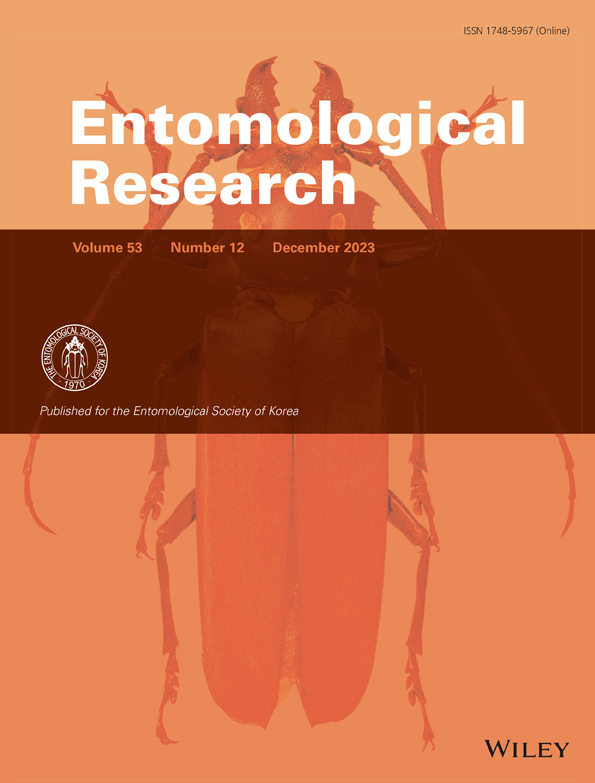Prevalence of dengue fever in Saudi Arabia: Jeddah as a case study
Abstract
Dengue fever is widespread in tropical and subtropical regions, including Saudi Arabia. Aedes aegypti (Diptera: Culicidae) transmits dengue and many other diseases, including chikungunya and Zika. This study provides an overview of dengue fever in Saudi Arabia since the first case was recorded in the early 1990s. In addition, it focuses on the epidemiological situation in Jeddah as a case study to study the spatial distribution of dengue cases using Geographic Information Systems (GIS) techniques over 5 years, from 2019 to 2023. The first recorded case in Saudi Arabia was in October 1993; however, daily data indicates that 2023 is a major epidemic year. The number of infections has reached 4099 so far during the first half of the year, which indicates a significant increase compared to previous years. GIS analysis has unveiled the locations of high infection rates across multiple municipalities, commonly called hotspots, and identified areas where dengue cases remain relatively low. The Inverse Distance Weighted (IDW) tool was used to determine the severity of infection in different areas of Jeddah. The study concluded that factors such as temperature, rainfall, and septic tanks in areas that lack a proper sanitation network are the most contributing factors to the spread of disease vectors and, thus, dengue. Winter rainfall creates conducive breeding environments for dengue mosquito vectors, increasing transmission rates. On the other hand, summer heat accelerates the mosquito life cycle and enhances viral replication, heightening the risk of dengue transmission.
Introduction
Febrile diseases such as dengue are mainly viral infections predominantly transmitted by Aedes mosquitoes, especially the Ae. aegypti and Ae. albopictus species (Mahyoub et al. 2018; Al-Hakimi et al. 2022). Aedes mosquitoes, especially Ae. aegypti and Ae. albopictus, are most commonly found in urban and semi-urban areas with warm and humid climates worldwide (Wu et al. 2009; Al-Hakimi et al. 2022). DF is a major concern in many countries, and its rapid spread can be attributed to various factors, including urban development, rapid transportation, trade, and travel to/from endemic countries (Aziz et al. 2014). Therefore, the geographical expansion of dengue continues to invade new countries in addition to the 128 already recognized as an epidemic. The WHO reports that more than 96 million infections are reported annually worldwide. Today, dengue fever has become a global disease primarily affecting tropical regions and is considered one of the most significant emerging tropical diseases (Fakeeh & Zaki 2001).
Saudi Arabia remained dengue-free until October 1993, when the first cases were reported, particularly in Jeddah city, indicating a significant shift in the disease's presence within the country. This city holds significant importance as it is located merely 75 kilometers away from Makkah. This destination draws millions of Muslims worldwide yearly for the Hajj and Umrah pilgrimages. At the beginning of 1994, cases of infection began to increase gradually, reaching 289 cases, as the first outbreak in SA (Fakeeh & Zaki 2003; Kholedi et al. 2012). The highest value of infections was observed in the city of Jeddah during the epidemiological history, from the first outbreak of the disease until 2022, in 2016, when 4436 cases were announced. According to prevailing forecasts, 2023 is expected to witness the largest outbreak of DF in Saudi Arabia. The number of reported infections has already surpassed the critical threshold of 4000 cases, and the outbreak is still ongoing, indicating that the situation is far from being resolved. This alarming trend has alarmed the relevant authorities, highlighting the urgent need for extensive measures to control the prevalence of the disease and mitigate its impact. Efforts must focus on reducing transmission and ensuring the health and safety of the population during this difficult period. Many studies have been conducted to discuss the issue of DF and the factors contributing to its prevalence in SA in general and Jeddah in particular, for example (Fakeeh & Zaki 2001, 2003; Khan et al. 2008; Kholedi et al. 2012; Khormi & Kumar 2012a, 2015; Al-Azraqi et al. 2013; Alwafi et al. 2013; Alzahrani et al. 2013; Aziz et al. 2014; Alhaeli et al. 2016; Alshabi et al. 2022) and some others have discussed ways to control dengue vectors using some natural products, for example (Özcan & Chalchat 2005; Tauil 2014; Mahyoub et al. 2016, 2018; Mendes et al. 2017; Algamdi & Mahyoub 2022; Aljameeli 2023). However, very few studies have discussed the epidemiological history of dengue fever in Jeddah since its inception. Using GIS techniques in spatial analysis to identify hot spots in Jeddah. Therefore, this paper discusses two main points: first, the epidemiological history of dengue in SA in general and Jeddah in particular, and second, the use of modern technologies (GIS) for spatial analysis of cases and highlighting the contributing factors to its occurrence, prevalence, and survival among the population.
Dengue virus (DENV) biology
DENV is one of the human arthropod viruses (arthropod-borne viruses) that belong to the group of enveloped RNA viruses, classified under the genus Flavivirus and the Flavivirus family. Five DENV serotypes have been found in several world regions (Forrester et al. 2012; Al-Tawfiq & Memish 2018). DENV has several serotypes, including DENV-1, DENV-2, DENV-3, DENV-4, and DENV-5, originally transmitted from Southeast Asia to different parts of the world (Khetarpal & Khanna 2016; Figueiredo 2019). The five aforementioned viruses have highly adaptive capabilities, cause a tropical epidemic disease called dengue, and are spread among people by anthropophilic mosquitoes such as Ae. aegypti or Ae. albopictus. The first mosquito is usually found inside homes and in urban areas, while the second is found outside homes, suburban cities, and rural areas (Braks et al. 2003; Altassan et al. 2019). In general, urban and suburban areas fuel the spread of dengue vectors, especially in warm and humid climate around the world, and water collection in gutters, pots, abandoned tires, and water tanks provide the ideal environment for vector breeding (Normile 2013). The females of these mosquitoes (Ae. aegypti) feed on blood to obtain the protein needed for oviposition, especially during the peak periods of mosquito bites in the early morning and before sunset (Braks et al. 2003). When a mosquito bites a host infected with dengue, the virus can be transmitted to the mosquito. After a mosquito acquires a virus from an infected host, the virus first replicates within the mosquito's midgut. This replication period is known as the extrinsic incubation period, typically lasting 8 to 12 days. After the incubation period, the virus moves from the midgut to the salivary glands to settle there and be transmitted to a new person during the next bite (Nedjadi et al. 2015).
Most cases of dengue may be asymptomatic. However, some cases are accompanied by flu-like symptoms. These symptoms usually appear between 3 and 10 days after exposure to an infectious mosquito bite (Altassan et al. 2019). The severity of DF varies in infected persons, depending on each person's acquired immunity. DF typically begins suddenly and is characterized by several symptoms, including high fever, headache, muscle aches, and severe pain, especially in the joints, back, and legs. That is why it is called bone-breaking fever. These symptoms continue from 2 to 3 days, and then the patient's condition improves, and the symptoms may return again with rashes occurring on separate parts of the body (Kliks et al. 1989; Katzelnick et al. 2017). However, very severe symptoms leading to dengue hemorrhagic fever (DHF) may occur if the person is infected for the second time with a virus different from the serotypes of the first infection. DHF is an advanced and more severe variant of DF that can lead to serious complications and, in some cases, be life-threatening. It typically occurs as a progression of dengue fever. Its danger may be due to a strong reaction of the patient's immune system to the second infection. This reaction causes severe damage to blood vessels, causing fluid to leak into the lungs in some cases, causing pulmonary edema, shortness of breath, and severe coughing. Moreover, bleeding can occur from the nose, mouth, and alimentary canal, and wounds and purple spots may appear on the skin. No specific antiviral treatment for DF is recommended by the WHO or other health authorities. Patients should get plenty of rest and drink sufficient amounts of water, knowing that neglecting patients' health care may lead to the possibility of a sharp drop in blood pressure and thus dengue shock syndrome (DSS) (Kliks et al. 1989; WHO 2009; Katzelnick et al. 2017).
Dengue vector biology and behavior
Mosquitoes are widely recognized as one of the most significant disease vectors due to their capability to transmit deadly epidemic diseases (WHO 1982). Mosquitoes belong to the order Diptera and the family Culicidae and are classified as arthropods. There have been approximately 3600 species identified, distributed across 37 genera (Harbach & Kitching 2016). Aedes aegypti is one of those species that has intrigued researchers due to a crucial role as the primary vector for numerous epidemic viral diseases such as DF, yellow fever, Zika, and chikungunya, especially in tropical and subtropical regions (Sabesan et al. 2010; Alyaha et al. 2018; Alyahya et al. 2021; Aljameeli 2023; Alyahya 2023). The transmission of these mosquito-borne diseases occurs due to the blood-feeding behavior of female mosquitoes. The female mosquito has piercing mouthparts (proboscis) that can pierce the skin and suck blood. Females need nutrients in the blood, such as protein, to produce eggs (Alyahya 2023). The eggs are laid in an optimal environment singly (about 100 eggs at a time), such as tree holes and bromeliad plants; nevertheless, mosquitoes have adapted to urban and semi-urban habitats and can now breed in artificial containers, such as buckets, discarded plastic containers, used tires, water collection tanks, gutters, water sinks, barrels, vases, buildings under construction, and rainwater puddles above the waterline (Trpis et al. 1973; Dieng et al. 2012). They endure drought and harsh conditions for months until conditions improve, and they are submerged in water and begin to hatch (CDC 2020; Alyahya et al. 2021). The life cycle of mosquitoes comprises four stages: eggs, larvae, pupae, and the adult stage (Fig. 1). Before puberty, the mosquito goes through four aquatic larval stages until it reaches the pupal stage, which then develops into an adult mosquito, and this period ranges between 8 and 10 days. Male mosquitoes usually emerge from pupae earlier, grow faster than females, stay 100–400 m away from the breeding area, and feed on flower nectar. Whereas females also feed on the nectar of plants, mating with the male occurs closer to the breeding site, usually at dusk, immediately after sunset. Female Ae. aegypti needs protein in a blood meal to produce eggs and mainly prefer human blood. Therefore, they live near human settlements, feeding during the daytime and making several stings during the peak in the early morning and at the end of the day before sunset. When a female mosquito feeds on the blood of a host infected with DENV, the virus travels to the midgut before moving to secondary tissues such as the salivary glands. The time from mosquito ingestion of the virus until transmission to another host is called the external incubation period and ranges from 8 to 12 days, especially at a temperature of 25–28°C (Scott et al. 2000). Notably, once a mosquito becomes a virus carrier, it can transmit to other people for the remainder of its life. The female lives for about 1 to 2 weeks (Southwood et al. 1972).
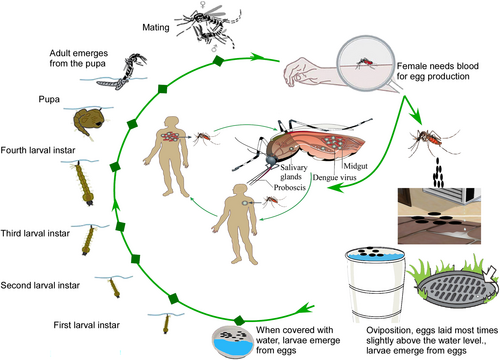
Dengue fever in the world
Due to the extensive geographical distribution of the virus and its vector, dengue is considered one of the most significant viral diseases transmitted by mosquitoes globally. The spread of the DENV and its vectors is not confined to limited areas but encompasses tropical and subtropical regions worldwide, particularly during the post-World War II era in the early 1950s. The rapid increase in urban development has been closely associated with a rise in dengue infections, epidemics, and hyperendemicity. This coupling has led to widespread dengue outbreaks and the emergence of new viral serotypes. According to the WHO reports, the number of countries where the epidemic spreads has reached 125 worldwide (Murray et al. 2013).
These countries have become endemic due to the lack or absence of vector control programs. The epidemic increased steadily from the 1970s to the 1980s, resulting in a global spread of viruses and disease vectors (Halstead 1992). During the past two decades, dengue cases have increased more than eight times, according to WHO reports, recording half a million (505,430) in 2000, 2.4 million in 2010, and 5.2 million in 2019 (Park et al. 2022). Global estimates indicate that infection cases are increasing in dengue-endemic areas due to the population increase, estimated at 3.6 billion people. Therefore, the infection rate is constantly increasing daily. According to recent global reports, the infections range from 50 to 200 M dengue infections, approximately 500k episodes of severe acute dengue called dengue hemorrhagic fever/dengue shock syndrome (DHF/DSS), and more than 20k dengue-related deaths occur annually (Gubler 2002; Shepard et al. 2011). Most mortality in many countries of the world affected by the DENV occurs among children (Guzmán et al. 2002; Hammond et al. 2005). The burdens resulting from dengue fever are not limited to human mortality but also huge economic burdens on countries. Shepherd et al. reported that the annual cost of dengue fever in all countries in the Americas is estimated at $2.1 billion, according to data provided by the PAHO between 2000 and 2007 (Shepard et al. 2011). A study was also conducted on 12 countries in Southeast Asia to determine the annual economic burden of dengue, which was estimated at $950 million, according to available data between 2001 and 2010 (Shepard et al. 2013). Infections reported by the World Health Organization are those reported; however, the number of actual infections may often exceed those reported due to poor disease surveillance, under-reporting by patients, low mortality, and difficulty in diagnosis (Beatty et al. 2011; Gubler 2011). Bhatt et al. He pointed out that the number of dengue infections worldwide is estimated at 390 million annually, including reported or unreported infections, which is twice what is reported in international reports (Bhatt et al. 2013). According to previous studies, it has been indicated that approximately 3.97 billion living across 128 countries are at risk of dengue fever on a global scale. Among this population, around 824 million individuals reside in urban areas, while approximately 763 million individuals reside in semi-urban areas (Brady et al. 2012). According to WHO reports, 125 countries have become endemic for DENV worldwide (WHO 2012).
DF in Saudi Arabia
Three decades ago, there was no disease called dengue in Saudi Arabia. However, Saudi Arabia is considered a destination for socioeconomic and religious activities, contributing significantly to transmitting the DENV from the infested countries to Saudi Arabia, especially with a competent mosquito vector such as Ae. aegypti, where the first case was recorded in 1993 in Jeddah city (Kholedi et al. 2012; Alhaeli et al. 2016). In 1994 Disease Control Division was established to surveillance dengue infections (Fakeeh & Zaki 2001, 2003; Kholedi et al. 2012; Alhaeli et al. 2016). In the same year, an outbreak of dengue fever occurred in Jeddah, 289 DF cases were recorded, and the first experiment isolated type 2 virus from a fatal case with DHF and another non-fatal case (Fakeeh & Zaki 2001, 2003). The infected cases recorded in 1995, 1996, and 1997 were 6, 2, and 15, respectively, and the viruses isolated in 1997 were mostly type 3 (Kholedi et al. 2012). However, in 1998, no cases of DF were reported in Jeddah or its vicinity. From 1998 to 2003, dengue cases ranged from 0 to 4 yearly, with zero cases reported in 1998, 2000, and 2001 (Kholedi et al. 2012). In 2004, a new outbreak occurred, and the number of reported cases reached 291, and most of the isolated viruses were of the 1, 2, and 3 types (Fakeeh & Zaki 2001). This outbreak has continued without a noticeable decrease until the present day (Fig. 2). The sharp increases were in 2013 and 2016, reaching 4407 and 4432, respectively. Most of these infections were recorded in the cities on the western side of SA, especially in Makkah and Jeddah (Aziz et al. 2014). This is due to several reasons, including the large number of visitors to these two regions annually, the availability of favorable conditions for disease vectors, such as storing domestic water, a warm climate, and modern and developed transportation. When looking at the map of dengue fever regions in Saudi Arabia (Fig. 2), we find that the prevalence of dengue fever has spread in several regions such as Makkah Al-Mukarramah, Madinah, Taif, Jizan, Najran, Riyadh, and Tabuk, which led to the declaration of Saudi Arabia as an endemic area in 2004 (Khan et al. 2008; Alzahrani et al. 2013); however, Jeddah remains the most prevalent city for dengue fever, followed by Jizan and then Makkah (Fig. 3).

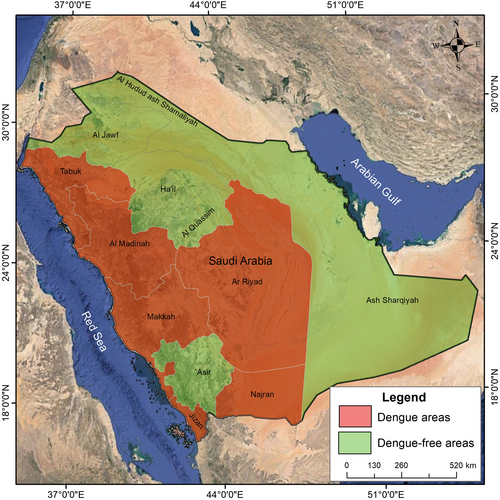
The first outbreak of DF was reported in Makkah in 2004 (Khan et al. 2008; Melebari et al. 2021) by isolates of DENV types 2 and 3 (Akan et al. 2007). From 2006 to 2008, 159 cases of infection were reported, especially during the spring and summer seasons. Between 2008 and 2012, a severe outbreak of dengue fever occurred in Makkah among construction workers, and about 4187 cases were recorded (Alwafi et al. 2013; Melebari et al. 2021). During 2017, 2018, and 2019, suspected cases of DF in Makkah reached 1004, 752, and 1571, respectively. However, the number of confirmed cases after diagnosis was 204 in 2017, 163 in 2018, and 748 in 2019 (Melebari et al. 2021). Most of the infections were concentrated in the age groups over 15 years because they spend most of their time outside the home, so they may be exposed to mosquito bites, especially at peak times at sunset, so the chances of contracting dengue are great. Also, the incidence of DF in males is higher than in women, and this may be explained by the fact that males stay for longer periods outside the home or the biological susceptibility to dengue fever in men and women differs. Because of the paucity of studies on dengue, there is a significant lack and data gap for dengue cases annually. In Madinah, no cases had been previously detected until the first case was reported in 2008, and DENV-1 and DENV-2 isolates were isolated there (El-Badry et al. 2014). According to the Saudi Public Health Authority reports, in 2022, Madinah recorded 20 confirmed cases of DENV until the international week 47. The same reports issued by the Saudi Public Health Authority for 2023 indicated that 36 suspected cases were recorded, of which 27 were confirmed cases and one death until the international week 23.
The dengue activity has never been reported in Riyadh; however, 48 cases of infection were recorded in 2022 for the first time, indicating the virus's horizontal expansion and the invasion of new areas in the Kingdom. During the year 2023 until the 23rd week, 12 suspected cases were reported, including four confirmed cases, according to the Saudi Public Health Authority.
Apparently, the first outbreak of the DENV in the southwest of the Kingdom, especially in Jizan, was in 2005, when the region was affected by several outbreaks (Al-Azraqi et al. 2013; Al-Tawfiq & Memish 2018). From 2006 to 2020, several outbreaks occurred in the Jizan region, and the number of reported cases reached 4619 cases (Zaki et al. 2008). During the period From April 2010 to March 2011, 553 suspected cases with dengue-like symptoms were reported, and 264 positive cases were confirmed (Gamil et al. 2014). Most of these cases occurred between April and May 2010, with 208 confirmed cases recorded (Gamil et al. 2014). This outbreak coincided with the spread of dengue fever in other regions, such as Jeddah and some adjacent countries, most likely due to the rains during that period, representing favorable conditions for the breeding and spread of mosquitoes (Aljameeli 2023; Alyahya 2023). Most dengue cases occurred among adults (15–44 years old). However, between 2019 and 2020, the number of cases significantly increased to reach 1654 cases in 2019 and 876 cases in 2020 (Zaki et al. 2008; Alshabi et al. 2022). The isolated types were three viruses of serotype DENV-1, DENV-2, and DENV-3, but type DENV-2 is the most prevalent in the Jizan region (Zaki et al. 2008).
Dengue fever in Jeddah from 2018 to 2023: A case study
Introduction
Dengue fever is a viral disease prevalent in tropical and subtropical regions, where climatic conditions favor its reproduction and spread (Julio et al. 2009; Alyahya 2023). This viral epidemic, dengue fever, is transmitted by arthropods such as the Ae. aegypti and Ae. albopictus mosquitoes worldwide (Fazal et al. 2013). Several studies reported that these two species transmit the dengue fever epidemic (Rudnick 1966; Vasilakis et al. 2011; WHO 2017; Altassan et al. 2019), however, in Saudi Arabia, only Ae. aegypti is spread, and no study has confirmed the presence of Ae. albopictus in any of the regions of Saudi Arabia. Thus, the female Ae. aegypti mosquito transmits the virus from one host to another (Aljameeli 2023). The female takes in the DENV while feeding on the blood of an infected host, which persists for a few days in the midgut and then salivary glands before being transmitted to another host (Nedjadi et al. 2015). The virus remains in the host for a few days, ranging from 8 to 12 days, before symptoms appear, after which the host becomes a new source of the virus (Scott et al. 2000). Dengue is a relatively recent epidemic; however, it has become a global concern due to its high incidence and rapid global spread (Viana & Ignotti 2013). Dengue is endemic in more than 125 countries, causing an incidence of approximately 100 million annually among the 3.9 billion people at risk of infection with the virus worldwide, mostly in the Asian continent (Brady et al. 2012). This geographical expansion and rapid epidemic spread of dengue fever are due to urbanization, transportation development, and climatic conditions (Gubler 2004; Phillips 2008).
Jeddah City is located in the western region of Saudi Arabia on the Red Sea, between latitudes 22° 24′ to 22° 55′ N and longitudes 38° 53′ to 39° 28′ E (Fig. 4). Jeddah is the second largest city in Saudi Arabia and the first in the Makkah Province (~550 km2) (Kholedi et al. 2012). It comprises 19 municipalities and is divided into three main sectors: the northern, southern, and middle sectors. It is also the largest Saudi seaport and is considered the western sea gate of Saudi Arabia. The population of Jeddah in 2023 was more than 3 million, representing a density of 2500 people per kilometer. Jeddah is characterized by a moderate climate, dry in winter and hot and humid in summer, with intermittent precipitation during the rainy months (November–May) with an annual average of about 52.5 mm/year (Al-Dubai et al. 2017). Relative humidity levels are estimated to be ~85% from September to October and ~34% from April to June (Abdullah et al. 2019). Due to the proximity of Jeddah city to Makkah, about 75 km, Jeddah is considered the western gate to Makkah. Therefore, Jeddah annually receives millions of pilgrims and Umrah performers through its airport and seaport from all countries, including countries affected by dengue fever. These visitors contributed significantly to transmitting the DENV from their countries to Saudi Arabia (Al-Saeed et al. 2017). The first case of dengue fever in Saudi Arabia was detected in October 1993 in Jeddah (Altassan et al. 2019). By February 1994, the first dengue outbreak occurred in Jeddah, and 289 fever cases were recorded (Fakeeh & Zaki 2001). In 2004, cases increased dramatically and reached their highest levels in 2016, with 4432 cases recorded (Organji et al. 2017).
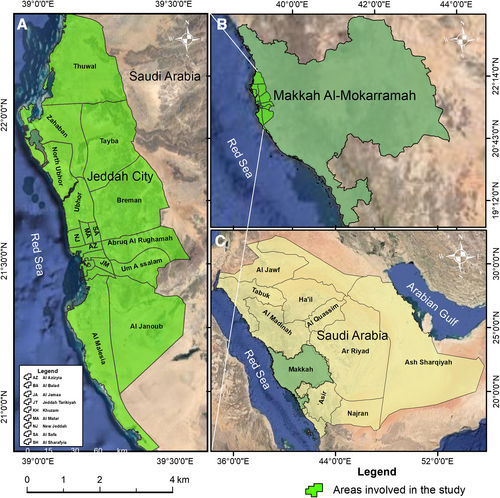
Several studies have been conducted on these topics related to this regard, including studies of biological control of vectors, whether chemical or biological treatment such as Mahyoub (2013, 2019, 2021); Mahyoub et al. (2016, 2017); Alyaha et al. (2018); Al-Zahrani Mohamd et al. (2019); Alyahya et al. (2021); Al-Rashidi et al. (2022); Al-Hakimi et al. (2022); Aljameeli (2023) and some studies concerned with evaluating the epidemiological situation in the Kingdom in general and Jeddah in particular such as Al-Azraqi et al. (2013); Alhaeli et al. (2016); Altassan et al. (2019); Al-Tawfiq and Memish (2018); Alwafi et al. (2013); Fakeeh and Zaki (2001, 2003); Kholedi et al. (2012); Melebari et al. (2021); Zaki et al. (2008). However, no studies have addressed the epidemiological situation in Saudi Arabia in general, and a case study of the epidemiological situation of Jeddah city most affected by dengue fever. Therefore, through a case study, we will study the epidemic in Jeddah city and identify the areas and districts most affected by dengue fever using Geographic Information Systems (GIS) techniques.
Methodology
Data processing by ArcMap GIS
The confirmed infection data in this study were obtained from the Ministry of Health (MH) in Jeddah and cover the period from 2019 to IW26 for 2023. The data were processed and formatted in a way that could be used for analysis. Then the coordinates were corrected and projected onto real infection sites in the main and sub-district of Jeddah using a GIS software called ArcGIS version 10.7. The number of injuries for each district was counted using the spatial analysis tools provided by ArcGIS. Using the spatial join feature, the obtained infection sites are linked to their actual geographical sites in provinces and municipalities. The geoprocessing tool is used to join the attributes of two classes of features based on the spatial relationships between the features. The total number of injuries/sub-regions was recorded for use in creating and preparing maps of the spatial distribution of injuries at the level of Jeddah.
Inverse Distance Weighted (IDW) method for spatial data analysis
Using point samples, spatial analysis of confirmed dengue cases reported by the MH in Jeddah, Saudi Arabia, was conducted using the IDW method, a useful spatial data analysis and interpolation tool. According to confirmed statistics from the Ministry, the number of dengue fever cases varies annually, as the infection was analyzed for each year separately. The values of locations for which data are not available are estimated from these available points. This method utilizes distance-weighted sample measurements to calculate missing values and construct a connected surface representing a geographically dependent variable; this specific variable decreases with increasing distance from the affected sample site (Khormi & Kumar 2015). After applying this method, the values of each cell in the output grid attribute were interpolated by taking the mean of the analyzed value for each point (Moran 1950). The results were displayed on maps showing six classes or six spatial patterns of dengue: areas free of infection, areas ranging from 1 to 2, areas ranging from 3 to 5, areas ranging from 6 to 10, areas ranging from 11 to 15 shown in light red, and areas greater than 15 infected shown in dark red.
Results and discussion
Epidemiological history and influencing factors
Two decades since the first case of dengue fever was recorded in the city of Jeddah in 1993 (Kholedi et al. 2012). After this year, cases gradually increased until the number of cases exceeded the threshold of 4000 in 2013 and 2016, representing a catastrophic situation that Saudi Arabia had not witnessed before. Therefore, Saudi Arabia has become endemic due to frequent and continuous outbreaks of dengue fever. Despite the great efforts of several specialized agencies to control the vectors, the dengue fever epidemic continues to increase annually. This is probably due to the random methods used to identify hotspots and mosquito breeding sites and correlate them with high-density areas of dengue fever, which ultimately leads to wasted money and time and the continued spread of the disease due to the low level of control. Tracking hotspots for mosquito breeding, breeding, and dispersal is complex, and a certain level of randomness may be involved. However, it is important to note that different approaches and technologies are available for tracking and monitoring mosquito populations, such as mosquito traps, satellite imagery, and GIS. Mapping the spatial distribution of dengue cases is a valuable tool that provides an immediate visual representation of areas at risk for the disease (Ashwini et al. 2020). Figure 5 shows the total positive annual dengue cases in Jeddah from 2019 to 2023 for all municipalities of Jeddah and reveals the gradual increase in infections. In 2019, 905 cases of dengue fever were reported in Jeddah, and 2020 806 cases were recorded, a decrease of 100 cases from the previous year. In contrast, cases doubled in 2021 and 2022, with 1902 and 1885 cases, respectively. The decrease in dengue fever cases in Saudi Arabia during 2019 and 2020 could be attributed to a combination of factors, including lower rainfall levels compared to previous years and the suspension of Hajj and Umrah procedures due to the COVID-19 pandemic. The suspension of Hajj and Umrah procedures has reduced the number of visitors to Saudi Arabia from all countries, including dengue-endemic countries, which may reduce the risk of the disease spreading. Alhaeli et al. (2016) mentioned that most of the dengue outbreaks occur in Jeddah and Makkah, and they explained that these cities annually receive about three million Muslims from all over the world who come to perform (pilgrimage) Hajj and Umrah. Altassan et al., they highlighted the factors associated with the emergence of dengue fever in general and Jeddah in particular. They attributed this to the large numbers of expatriate workers and pilgrims coming from areas endemic with dengue fever, especially the Middle East, North Africa, and Asia (Altassan et al. 2019).
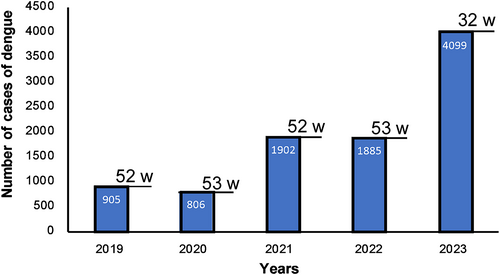
On the contrary, there was a steady increase in infections after 2020, probably due to the decision to allow entry into Saudi Arabia after the Corona epidemic, leading to an increase in the number of visitors to Saudi Arabia. Moreover, the important role of rain and climatic conditions such as temperature and relative humidity are favorable conditions for disease vectors (Khormi & Kumar 2012a, 2012b). Dengue outbreaks often coincide with monsoon rains, particularly in the Jeddah region (Fig. 6). The monsoonal rain provides pockets of standing water around human dwellings, which are ideal breeding sites for the Aedes mosquitoes that transmit the DENV. As a result, the risk of dengue transmission increases during and immediately after the rainy season, increasing dengue cases. Jeddah is situated in a transitional zone between areas affected by the northern Mediterranean climate, characterized by winter rains, and areas influenced by the southern monsoon climate, characterized by summer rains. Unlike regions influenced by the northern Mediterranean and monsoon climates, Jeddah experiences relatively low precipitation levels during the winter and summer, typically in light showers (Al-Dubai et al. 2017; Bantan et al. 2019). The rainfall rate in Jeddah is slightly higher in winter than in summer, and therefore the incidence of dengue fever is greater in winter than in summer, as shown in Fig. 6. This indicates the role of precipitation more than other environmental factors (Alhaeli et al. 2016). This indicates the role of precipitation more than other environmental factors. Moreover, environmental factors such as temperature and relative humidity also play a critical role in dengue transmission, alongside rainfall. Altassan et al. mentioned that moderate temperatures and high humidity in Jeddah may create favorable conditions for the spread of dengue fever, as these environmental factors can facilitate mosquito breeding and survival, which in turn can lead to an increase in the transmission of the virus (Altassan et al. 2019). Several authors have reported that dengue transmission is highly sensitive to climatic conditions, particularly temperature, precipitation, and relative humidity (Khormi & Kumar 2012a, 2012b; Morin et al. 2013; Horta et al. 2014; Alhaeli et al. 2016).
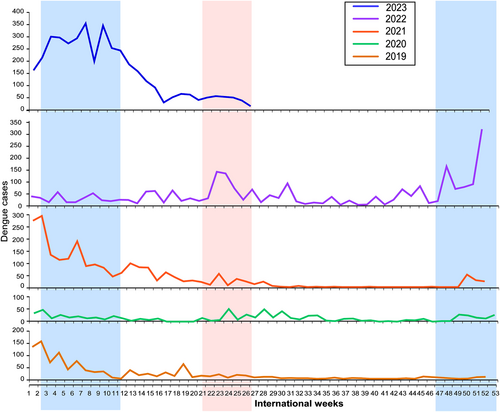
Spatial distribution of dengue cases
The IDW method calculated the spatial distribution of dengue cases in Jeddah city between 2019 and 2023. Depending on the number of dengue cases reported by the MH in Jeddah city, high and low-density areas were distinguished in the study area. In 2019, there were 905 confirmed cases of dengue fever in Jeddah. This available data shows that Jeddah has the highest incidence of dengue fever compared to other cities in Saudi Arabia. However, these cases may be lower than those reported in other countries. Figure 7 shows the locations of the high density of dengue cases during 2019, which are shown in red in seven regions in Jeddah and include the municipalities of Um Assalam, Al Safa, Al Azizia, Al Matar, Al Sharafyia, Tayba, and Al Malesia. While 806 cases of infection were reported in 2022, only four municipalities have the highest densities, including Umm Al-Salam, Al Safa, Al Azizia, and Al Matar. In 2021, the number of infections increased significantly, exceeding the threshold of a thousand, and the total number of cases reached 1902 by the end of International Week 52. During this year, new districts and municipalities appeared with dengue fever, including Um Assalam, Al Safa, Al Azizia, Al Matar, Al Sharafyia, Tayba, Al Malesia, Al Janoub, Khuzam, Al Balad, New Jeddah, and north Ubhor, as shown in Figure 7. In 2022, HM reported a total of 1885 confirmed cases of dengue fever over a period of 53 international weeks in Jeddah city. These cases were concentrated in districts and sub-municipalities that have experienced high-density dengue cases over the past 3 years. This suggests that there may be ongoing virus transmission in these areas and highlights the need for targeted surveillance and control measures to prevent further spread of the disease. 2023 is an exceptional year for dengue fever in Jeddah; although it is still mid-year, the incidence of dengue fever has crossed the threshold of 4000 confirmed cases (Figs. 5-7). Most of the injuries were in the municipalities of Um Assalam, Abruq Al Rughamah, Al Janoub, Al Malesia, Tayba, New Jeddah, and Breiman. The rapid increase in dengue fever infections makes Jeddah the most affected city among the Saudi Arabia cities and includes it among the endemic areas of the disease. Despite the control and monitoring programs in Jeddah, there is an urgent need to strengthen those programs for monitoring, reporting, and controlling dengue vectors on a studied and scientific basis to ensure the achievement of the objectives of control campaigns. Therefore, dengue infection is still on the rise, which is cause for concern. This is due to several reasons, including warm and humid environments, rain, urbanization, Hajj and Umrah (visitors), and poor sanitation and hygiene. Warm and humid climatic conditions promote mosquito breeding and spread since they are optimal for disease vectors (Khormi & Kumar 2012a, 2012b). Therefore, cities in low-lying and coastal areas are most vulnerable to mosquito-borne diseases due to standing water and the high humidity levels that favor mosquito breeding. Al-Azraqi et al indicated that the high number of confirmed cases of infection in Jazan can be attributed to the city's relatively low and flat topography at sea level. This makes Jazan vulnerable to collecting water flowing from the neighboring highlands during the rainy season (Al-Azraqi et al. 2013). Numerous studies have demonstrated the correlation between DF and various climatic and environmental factors, including humidity, temperature, and rain, between 1991 and 2012. These studies displayed that climatic conditions mainly affect the transmission of dengue, especially rain, temperature, and humidity (Horta et al. 2014). The epidemiological curve contains some peaks during the summer weeks, indicating increased dengue cases due to higher temperatures and humidity levels. A similar study in Brazil confirmed that an outbreak of dengue fever increases directly with the rise in temperatures (da Teixeira et al. 2002; Larrieu et al. 2014). Our results are consistent with those of studies conducted in Southeast Asia, particularly in Thailand, where the prevalence of dengue increases with temperature (Angiolella et al. 2018). On the other hand, the peaks of the epidemiological curve occur between November and February (winter), indicating an increase in the number of cases due to the intermittent and not heavy rains that fall on Jeddah annually at this time, more than in any other season. Kholedi et al. reported that the increase in dengue cases usually occurs in the fourth quarter of each year in Jeddah (Kholedi et al. 2012). They attributed this to the rains during this period, leading to water accumulation in the districts and low-lying and the increased density of mosquitoes that transmit dengue fever. Fortunately, these rains are often sporadic and short during this period, and cases decrease with the beginning of the year's second quarter.
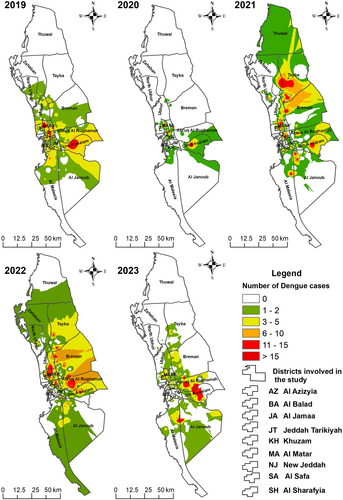
In addition to the reasons above, the homes of the popular and unknown districts lack a public sewerage network, and they have underground septic tanks. These tanks often seep to the surface to form sewage leaks, representing ideal breeding environments for mosquitoes. Wu et al. stated that high infections are closely related to the region's low standard of living and degree of urbanization (Wu et al. 2009).
Implementing GIS analytical methods can be of high value in studying dengue fever (DF) in Jeddah and Saudi Arabia. These approaches enable researchers to examine the spatial distribution of DF cases and vector populations, providing insights into disease patterns and dynamics (Khormi & Kumar 2012a, 2012b, 2015). Mapping the spatial distribution of DF cases and identifying hot spots or disease groups facilitates many tasks, including quick access to epidemic sites, reduces control costs, facilitates understanding of the geographical spread of the disease, and thus disease control and management, and also helps the relevant authorities in making urgent decisions to confront any epidemic. Thus, GIS technologies are a quantum leap because they provide easy ways and means to control and manage diseases.
Conclusions
Dengue fever is a viral disease endemic in many regions, and an outbreak was noted in Saudi Arabia in the early 1990s. Specifically, the first case was recorded in Jeddah in 1993 and may have been transmitted through visitors from areas affected by the epidemic, especially during the Hajj and Umrah seasons. However, the first reported outbreak was in 1994, with a total number of 289 cases. This epidemic is transmitted by the Ae. aegypti mosquito, the main vector of dengue fever. The spread of this epidemic continues as long as the environmental and climatic conditions are favorable for the survival and reproduction of the vector, and these factors include temperature, humidity, rain, stagnant water pools, the spread of open septic tanks, and the lack of proper sanitation in some areas. Spatial analysis of dengue fever infection in Jeddah was performed using the IDW method available in ArcMap GIS applications. This study showed that using these techniques is an effective tool in determining the spatial patterns of dengue infection in a centralized manner. Thus, using these newer technologies to create dengue epidemiological maps greatly benefits the decision-making authority to implement preventive strategies and measures to control the epidemic in control programs.
Acknowledgments
The author deeply thanks everyone who contributed advice, suggestion, and review to this paper.



